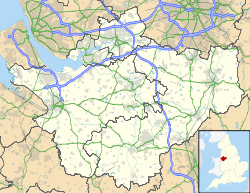- St Peter's Church, Congleton
-
St Peter's Church, Congleton 
St Peter's Church, Congleton, from the southeastLocation in Cheshire Coordinates: 53°09′42″N 2°12′42″W / 53.1618°N 2.2116°W OS grid reference SJ 859 628 Location Congleton, Cheshire Country England Denomination Anglican Website Congleton Team Parish History Dedication Saint Peter Architecture Status Parish church Functional status Active Heritage designation Grade I Designated 28 July 1950 Architect(s) William Baker Architectural type Church Style Tower Gothic
Body of church NeoclassicalCompleted 1786 Specifications Materials Red brick with stone dressings
Stone slate roof
Stone towerAdministration Parish Congleton Deanery Congleton Archdeaconry Macclesfield Diocese Chester Province York Clergy Vicar(s) Rev Canon David Taylor Laity Parish administrator Claudette Tilley St Peter's Church, Congleton is in the town of Congleton, Cheshire, England. It has been designated by English Heritage as a Grade I listed building.[1] It is an active Anglican parish church in the diocese of Chester, the archdeaconry of Macclesfield and the deanery of Congleton. Its benefice is combined with those of St Stephen, Congleton, St John the Evangelist, Buglawton, and Holy Trinity, Mossley.[2] Alec Clifton-Taylor includes it in his list of 'best' English parish churches.[3]
Contents
History
The original church was built on the site in the early 15th century as a chapel of ease to St Mary, Astbury.[4] It was timber framed and by 1740 its structure had become decayed. A new church was built in the Neoclassical style and completed by 1742.[5] The tower was raised in 1786.[4] The lower part of the 14th century tower was retained.[5] The architect was William Baker of Audlem.[1] In 1829–40 the church was extended at the west end by one bay on each side of the tower, and a porch was added, also at the west end, by Joshua Radford.[4]
Architecture
Exterior
The church is built in red brick with stone dressings, the roof is of stone slate and the west tower is of stone.[1] Its plan consists of a five-bay nave continuous with a single-bay chancel, and north and south aisles . The tower is at the west end.[6] The tower has a clock and on its summit is a parapet and pinnacles. Two coats of arms are carved on the western wall.[5] The door is at the west end end is surrounded by a porch with Doric columns.[1]
Interior
Internally there are galleries on the north, south and west sides, and Georgian box pews. The pulpit dates from the 17th century and, at the time Richards was writing, it was the only pulpit in Cheshire to be placed in front of the sanctuary in the middle of the nave.[5][7] Between the nave and the aisles are square piers supporting Tuscan columns. The marble font dates from 1742 and a brass candelabrum from 1748. The reredos is dated 1743 and its panels contain the Lord's Prayer, the Ten Commandments and the Apostles' Creed. The east window is Palladian in style and it is flanked by mural paintings of Saint Peter and Saint Paul by Edward Penny of Knutsford. The royal coat of arms of William III dated 1702 are at the east end of the north gallery.[5]
The only stained glass is in the east window. Part of this dates from about 1740, and depicts the Holy Spirit as a dove. Below this is glass dating from about 1922.[4] The finest memorial is a wall tablet in memory of Sir Thomas Reade who died in 1849.[5] This is by Thomas and Edward Gaffin and shows a native kneeling by a palm tree. There are more wall tablets dating from the 19th century, and monuments from the 18th and 19th centuries.[4] The organ was built in 1824 by Renn and Boston and was rebuilt in 1911 by Steele and Keay.[8] The ring is of eight bells. The oldest four were made by Rudhall of Gloucester, three in 1720 and one in 1757. The other four were cast at the Whitechapel Bell Foundry, one by Thomas Mears and Son in 1806, and the others by Mears and Stainbank in 1867.[9]
External features
The gates, gate piers and railings of the churchyard are listed Grade II. The gate piers are of stone with panelled sides and cornice caps. The gates and railings are in wrought iron. Over the gate is a wrought iron overthrow and a lantern.[10]
References
- ^ a b c d "Church of St Peter, Congleton", The National Heritage List for England (English Heritage), 2011, http://list.english-heritage.org.uk/resultsingle.aspx?uid=1330322, retrieved 28 April 2011
- ^ St Peter, Congleton, Church of England, http://www.achurchnearyou.com/congleton-st-peter/, retrieved 14 December 2010
- ^ Clifton-Taylor 1974, p. 240.
- ^ a b c d e Hartwell et al. 2011, pp. 296–298.
- ^ a b c d e f Richards 1947, pp. 137–141.
- ^ Morant 1989, p. 126–127.
- ^ Clifton-Taylor 1974, p. 8.
- ^ Congleton St. Peter, British Institute of Organ Studies, http://www.npor.org.uk/cgi-bin/Rsearch.cgi?Fn=Rsearch&rec_index=D02315, retrieved 10 August 2008
- ^ Congleton S Peter, Dove's Guide for Church Bell Ringers, http://dove.cccbr.org.uk/detail.php?searchString=congleton&Submit=++Go++&DoveID=CONGLETON, retrieved 10 August 2008
- ^ "Gate piers, gates and railings of St Peter's Churchyard, Congleton", The National Heritage List for England (English Heritage), 2011, http://list.english-heritage.org.uk/resultsingle.aspx?uid=1335892, retrieved 28 April 2011
- Bibliography
- Clifton-Taylor, Alec (1974), English Parish Churches as Works of Art, London: Batsford, ISBN 0-7134-2776-0
- Hartwell, Claire; Hyde, Matthew; Hubbard, Edward; Pevsner, Nikolaus (2011) [1971], Cheshire, The Buildings of England, New Haven and London: Yale University Press, ISBN 978-0-300-17043-6
- Richards, Raymond (1947), Old Cheshire Churches, London: B. T Batsford
- Morant, Roland W. (1989), Cheshire Churches, Birkenhead: Countyvise, ISBN 0-907768-180
External links
- Photographs of Congleton by Craig Thornber including the church
- Information about the stained glass from Corpus Vitrearum Medii Aevi (CVMA) of Great Britain
Categories:- Church of England churches in Cheshire
- Grade I listed churches
- Grade I listed buildings in Cheshire
- English Gothic architecture
- Neoclassical architecture in England
- Diocese of Chester
Wikimedia Foundation. 2010.

